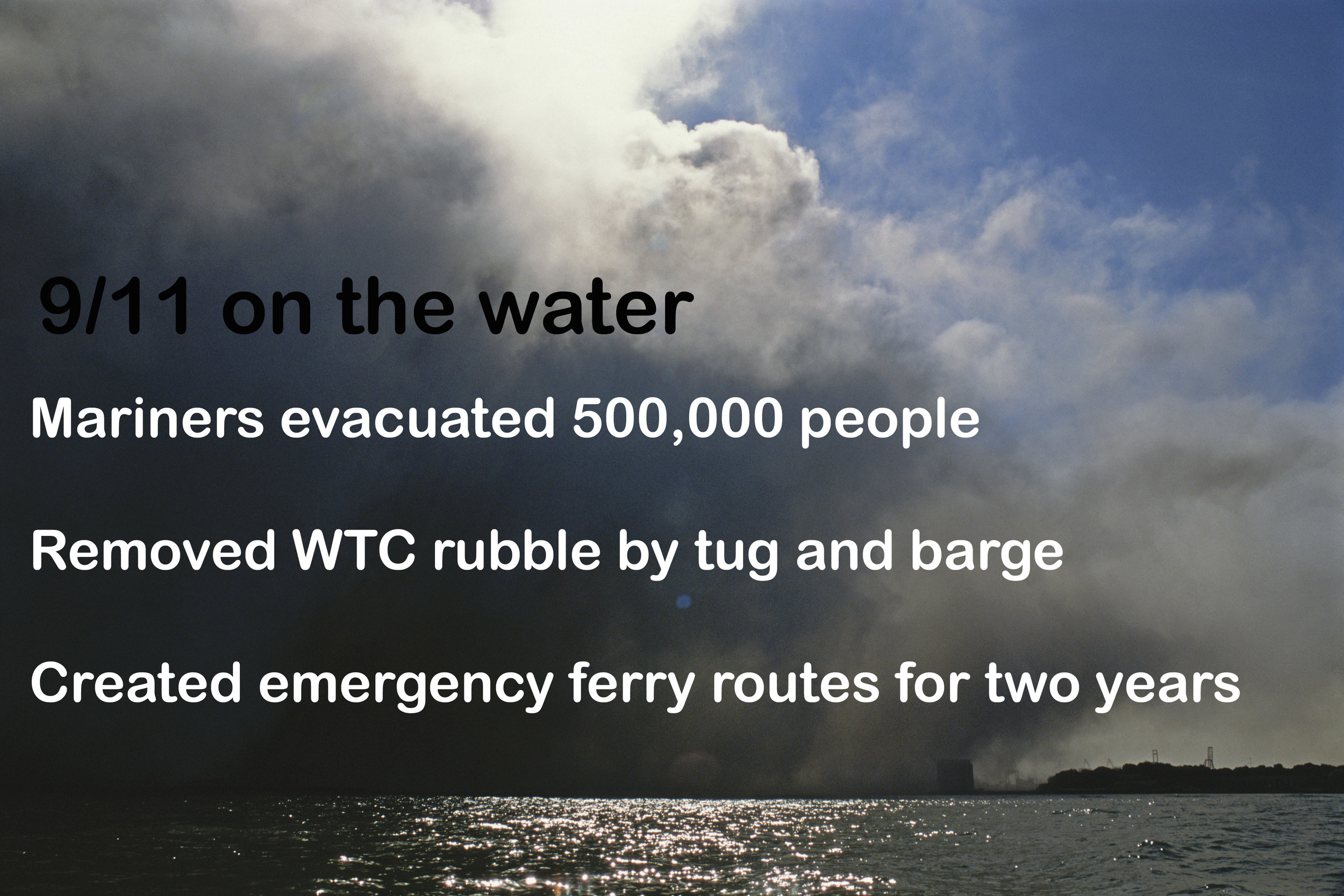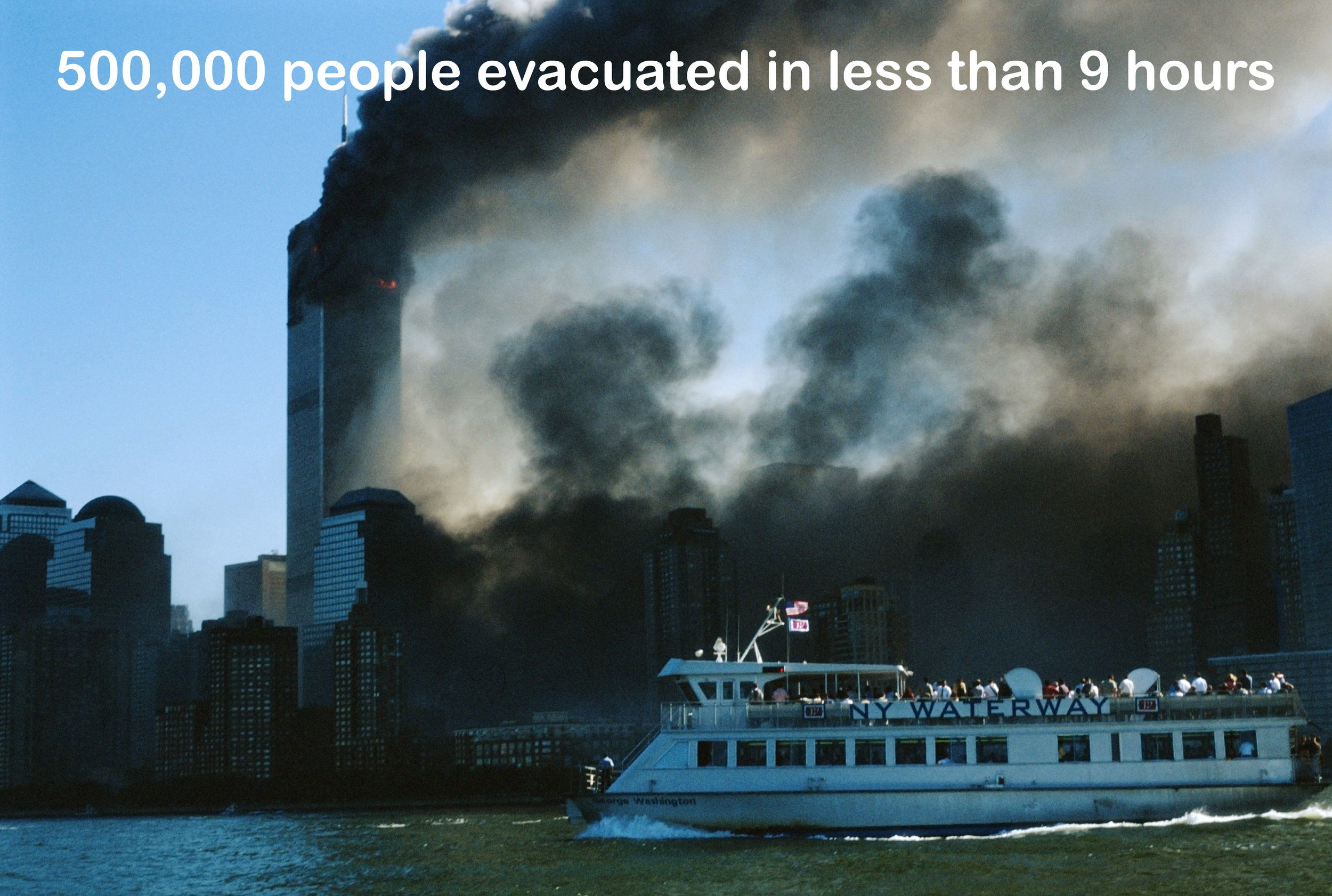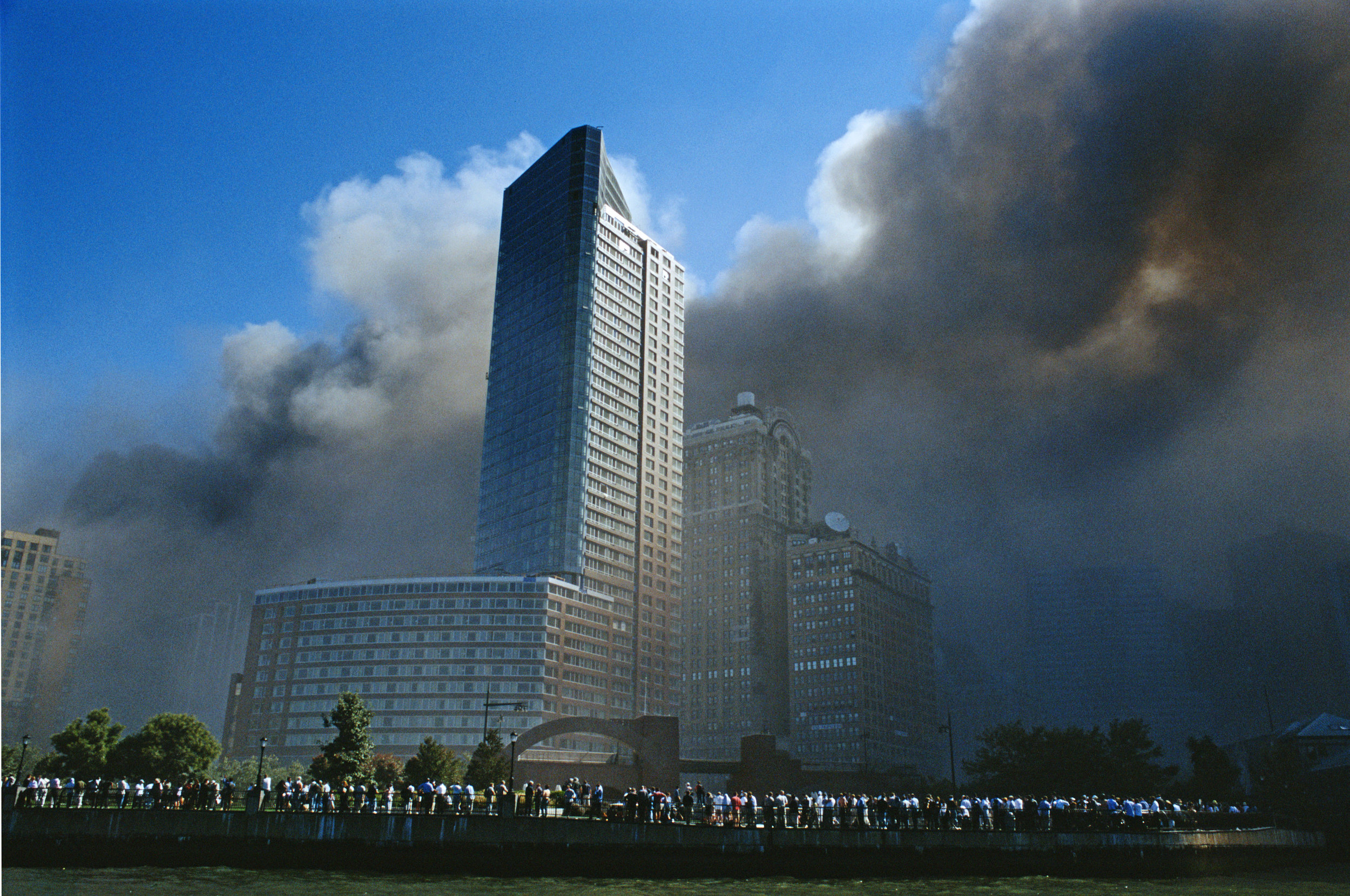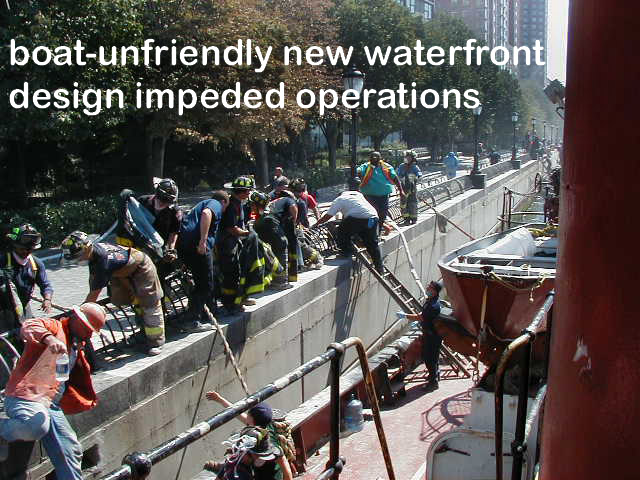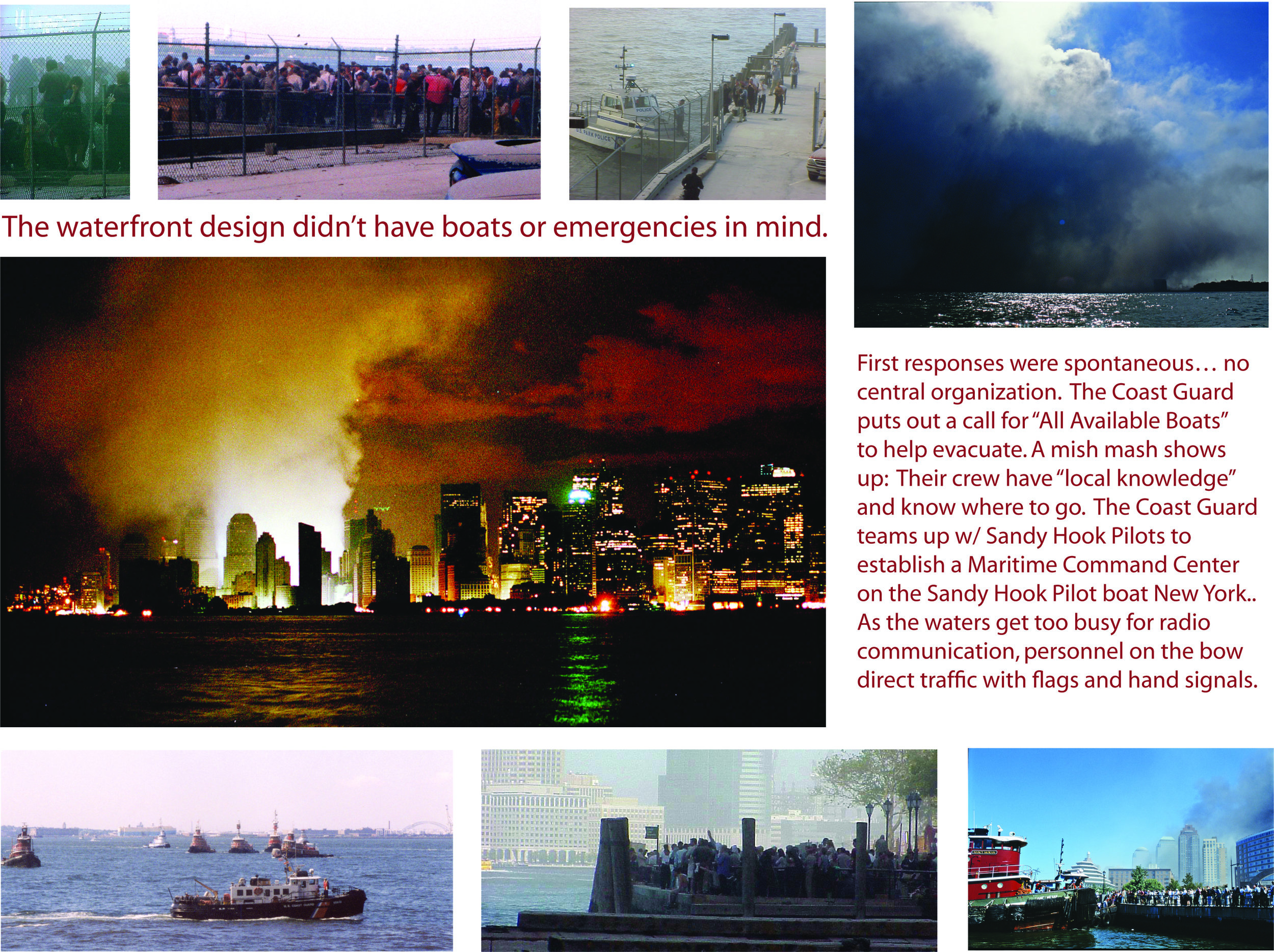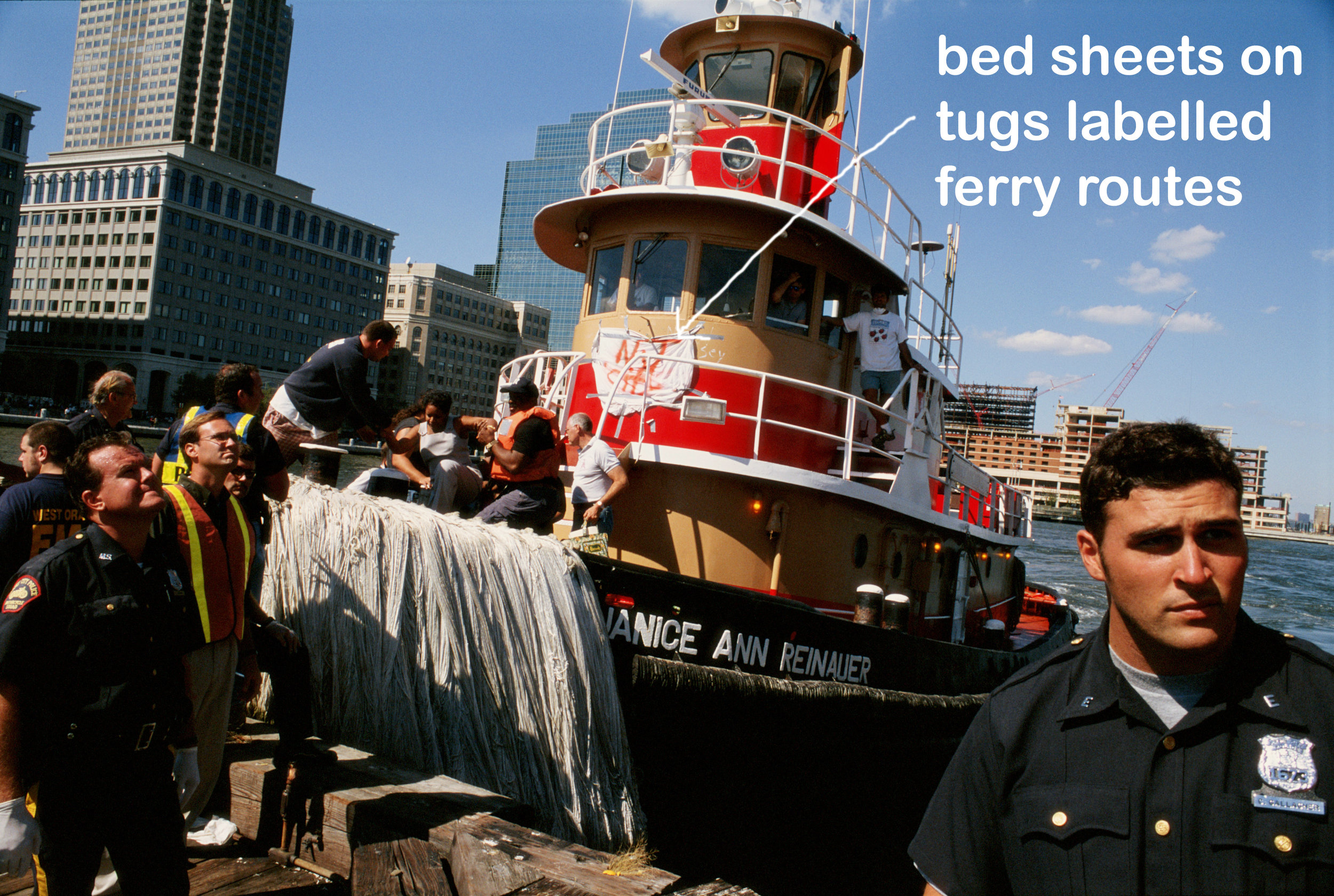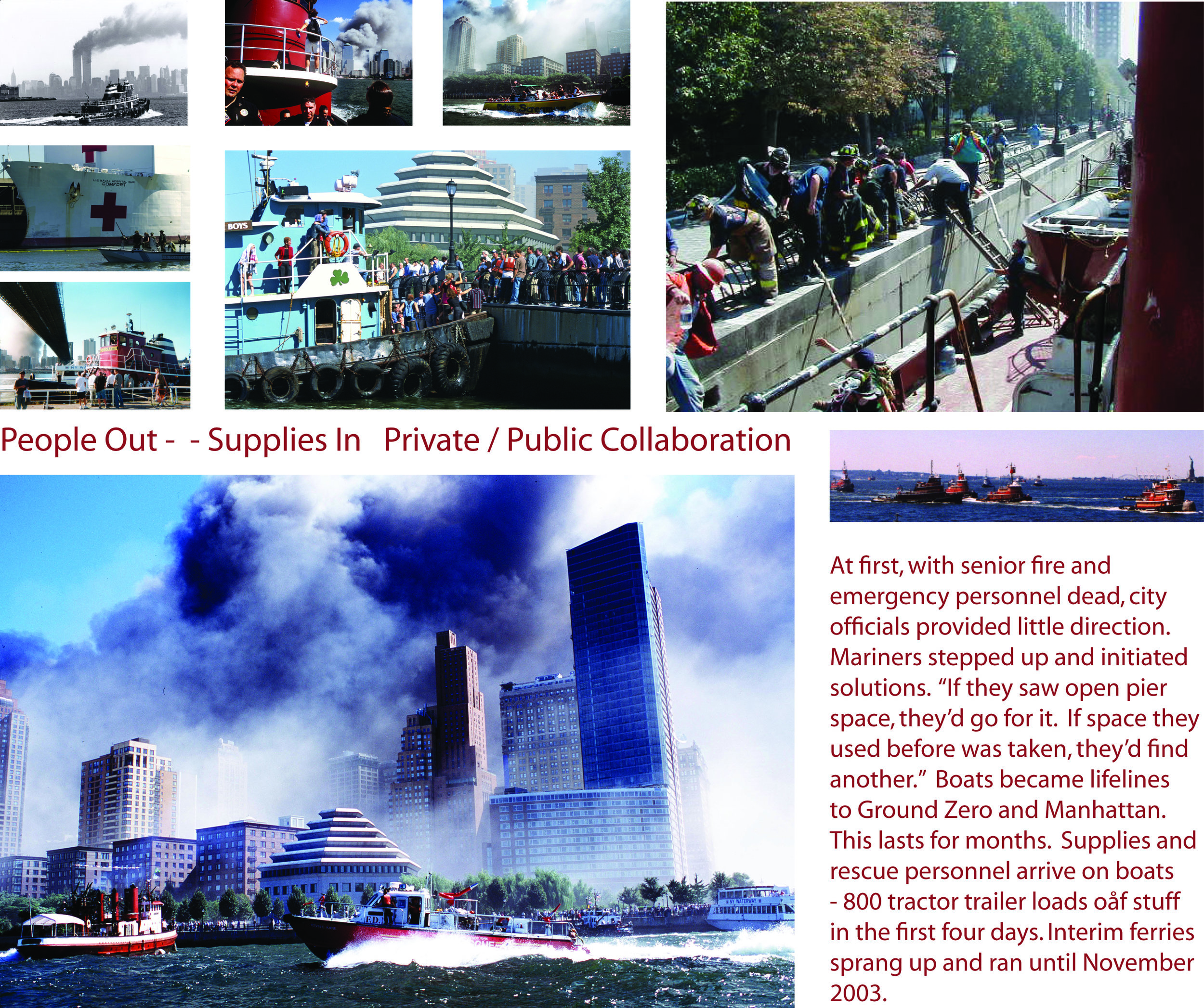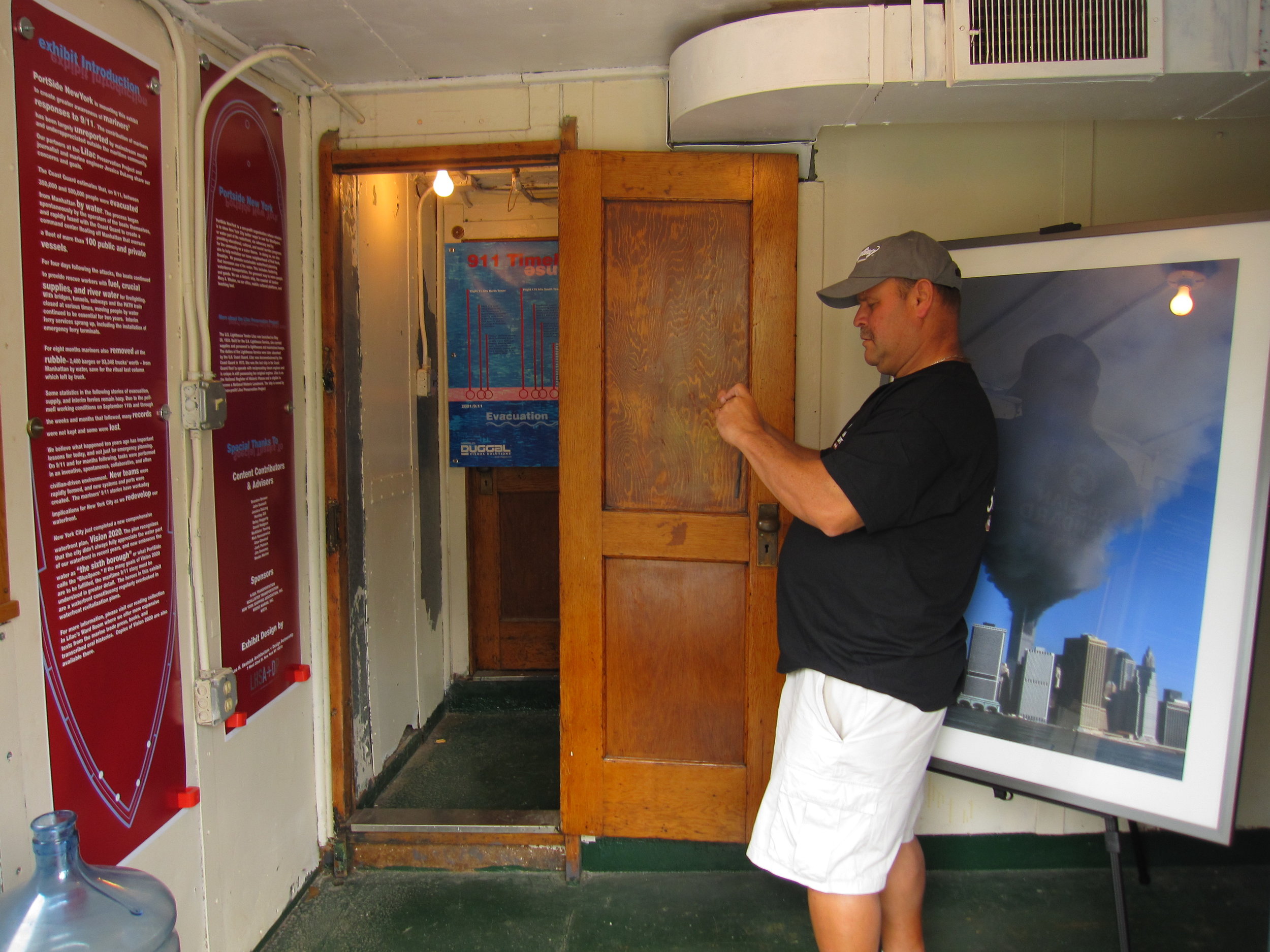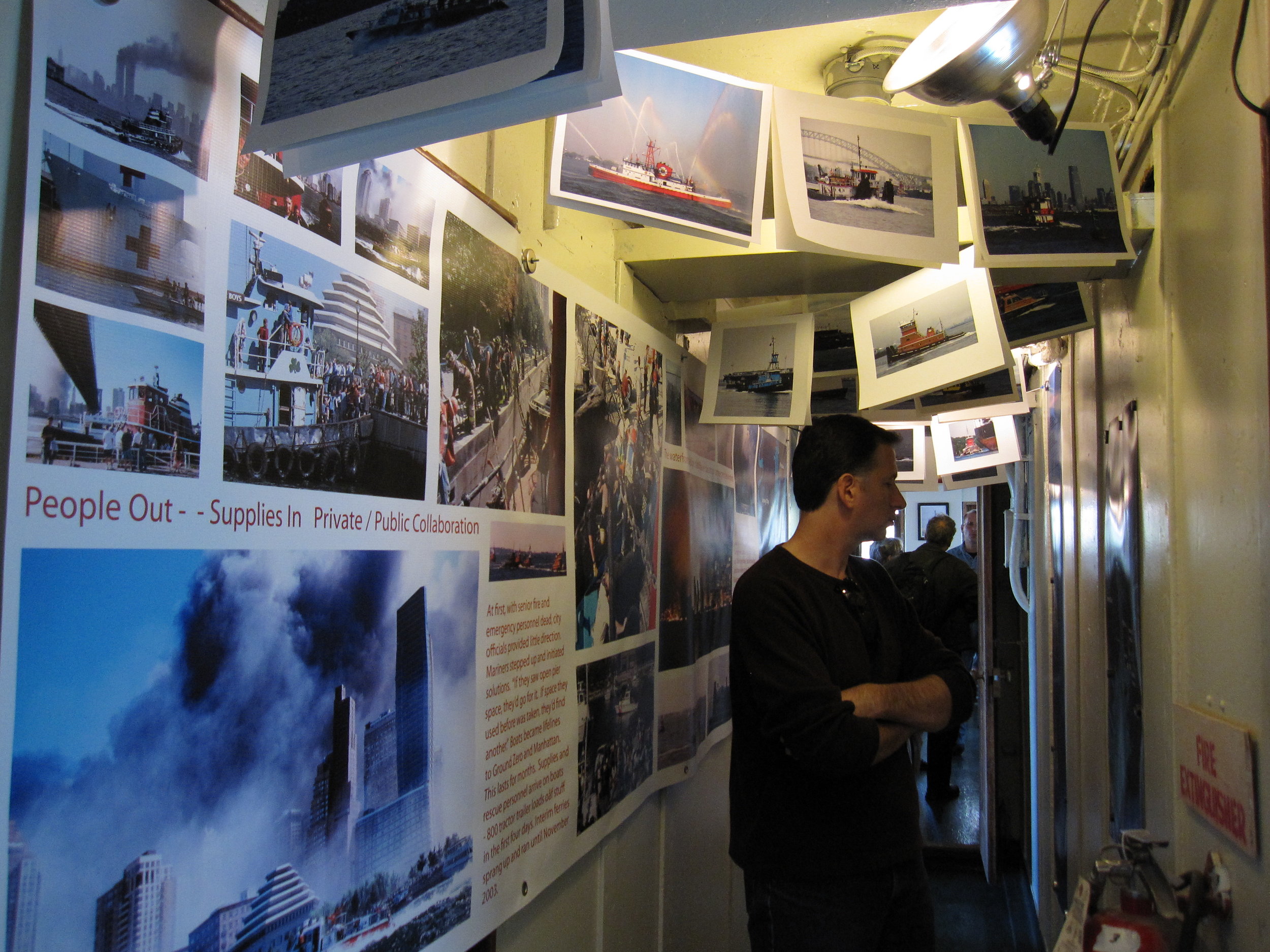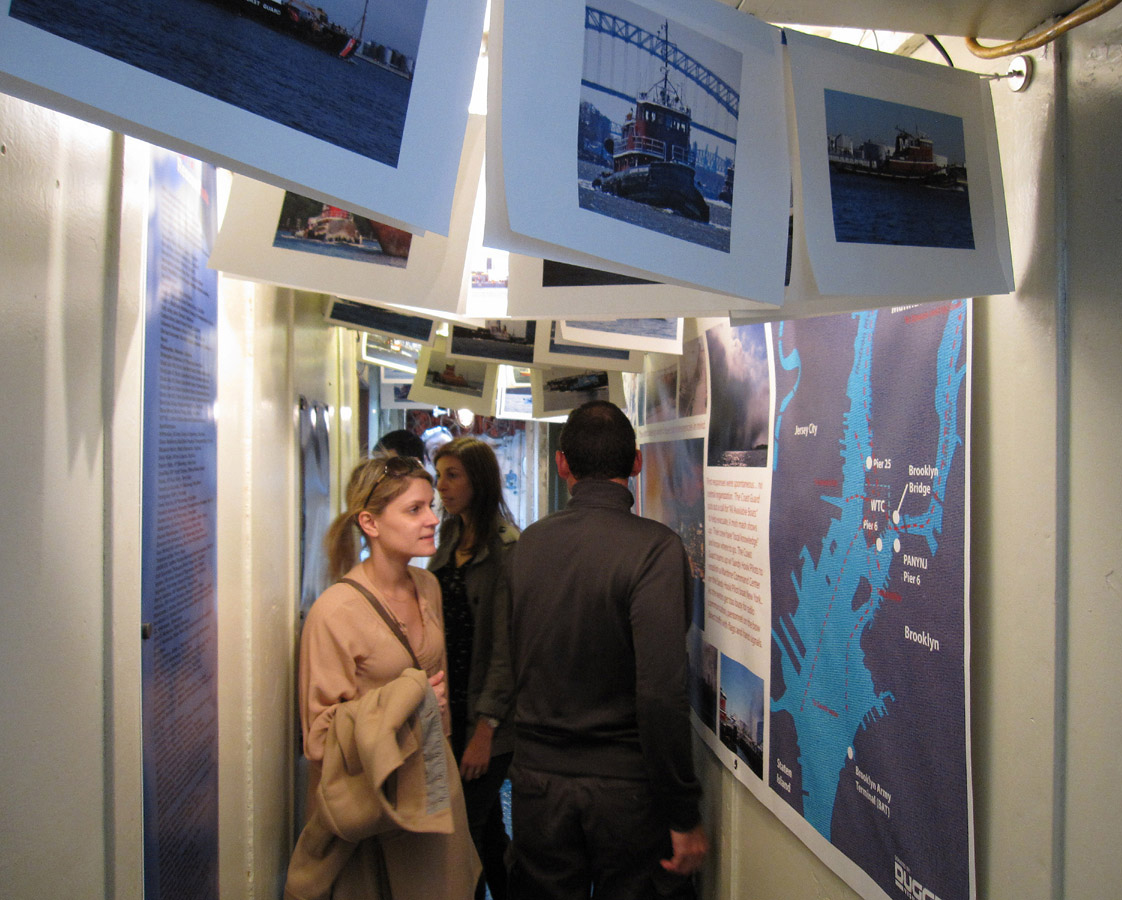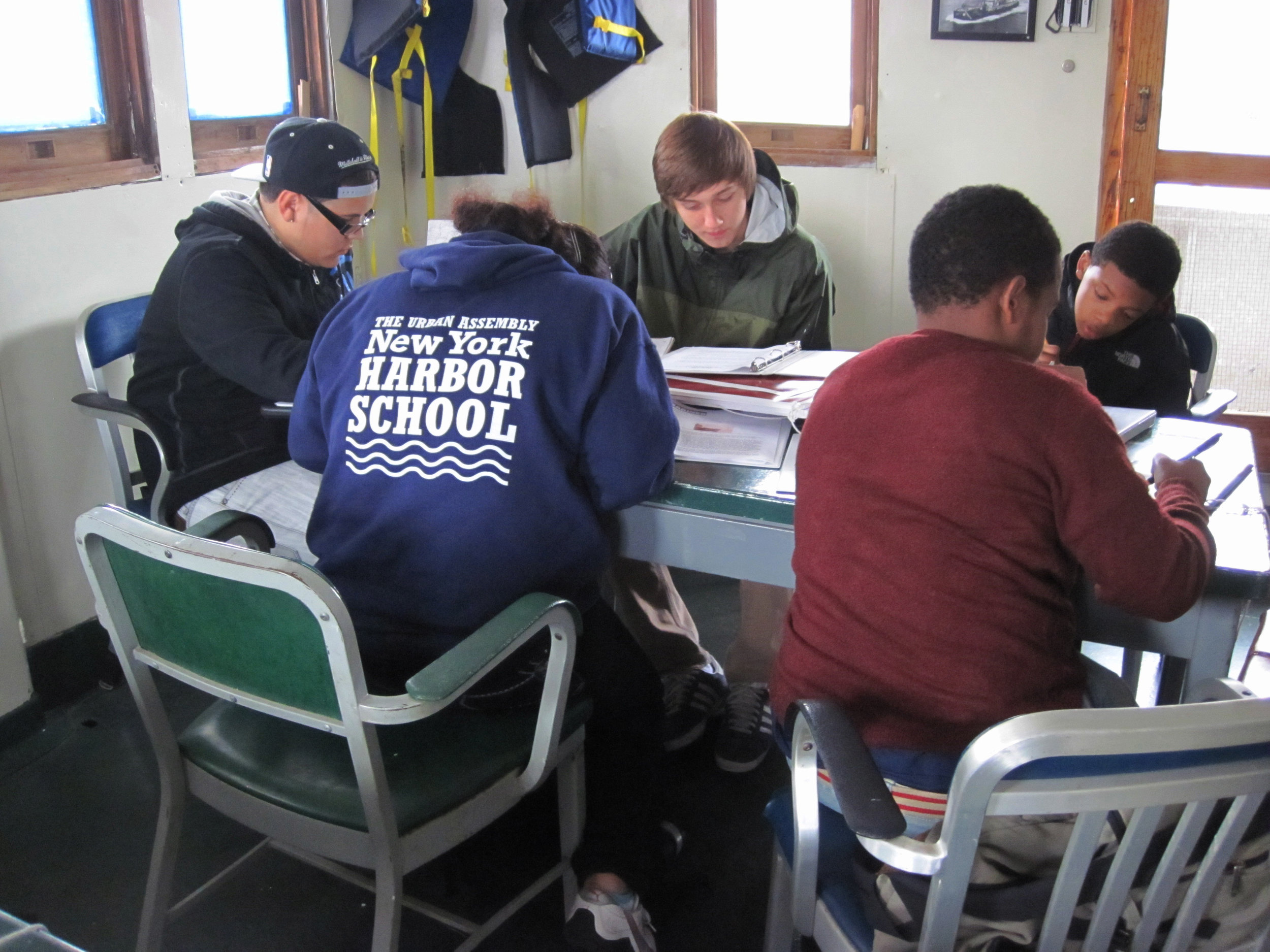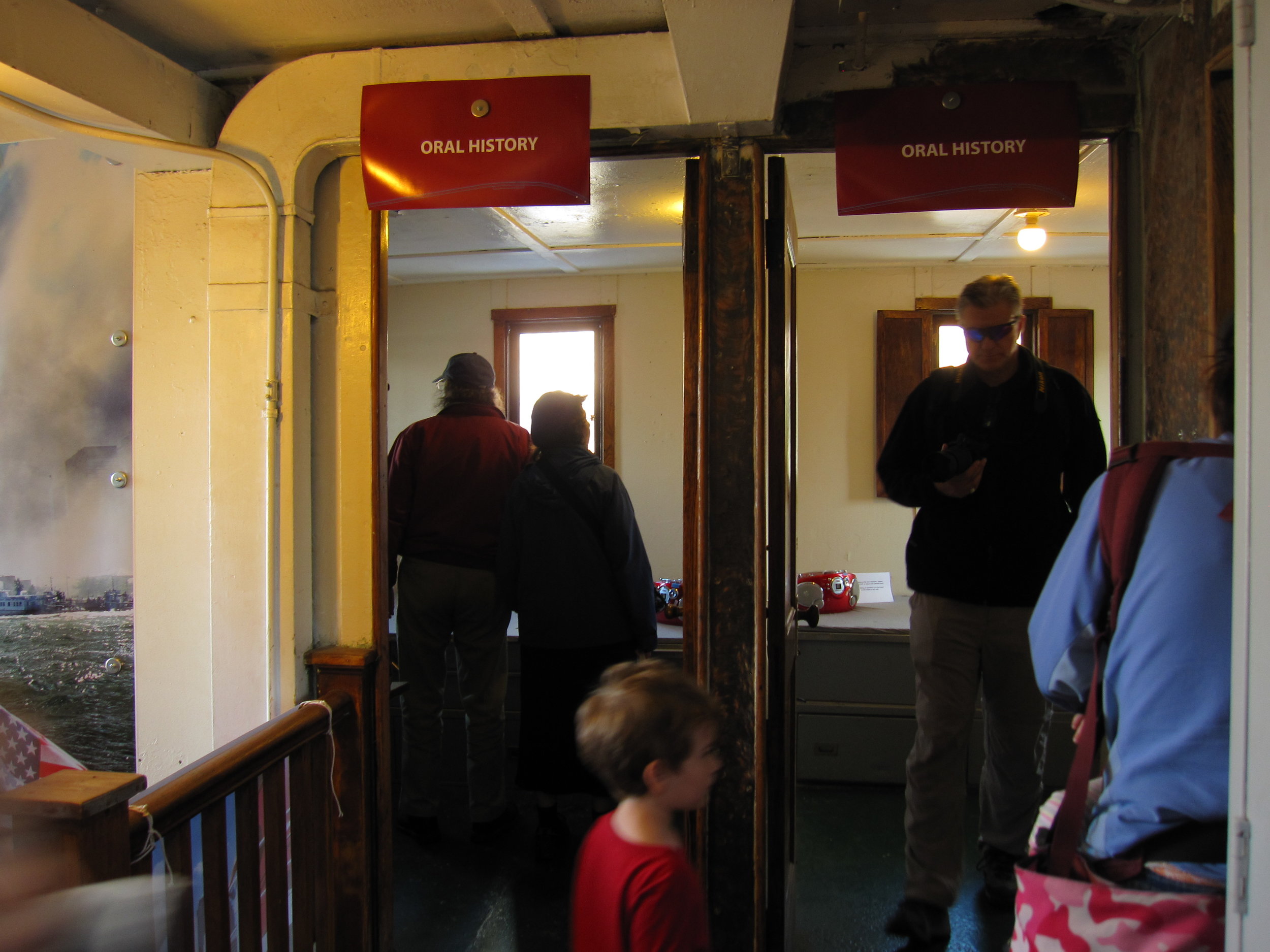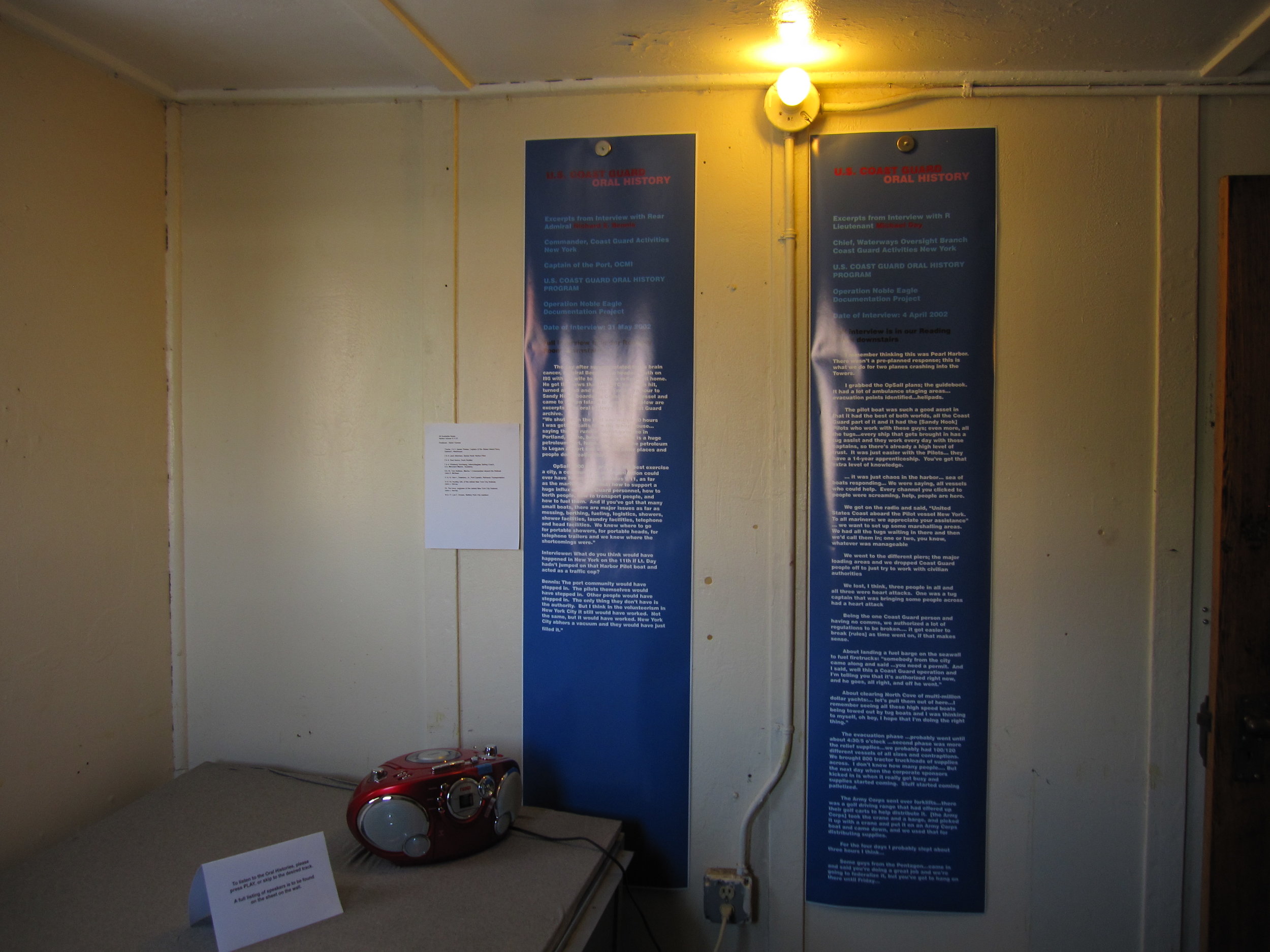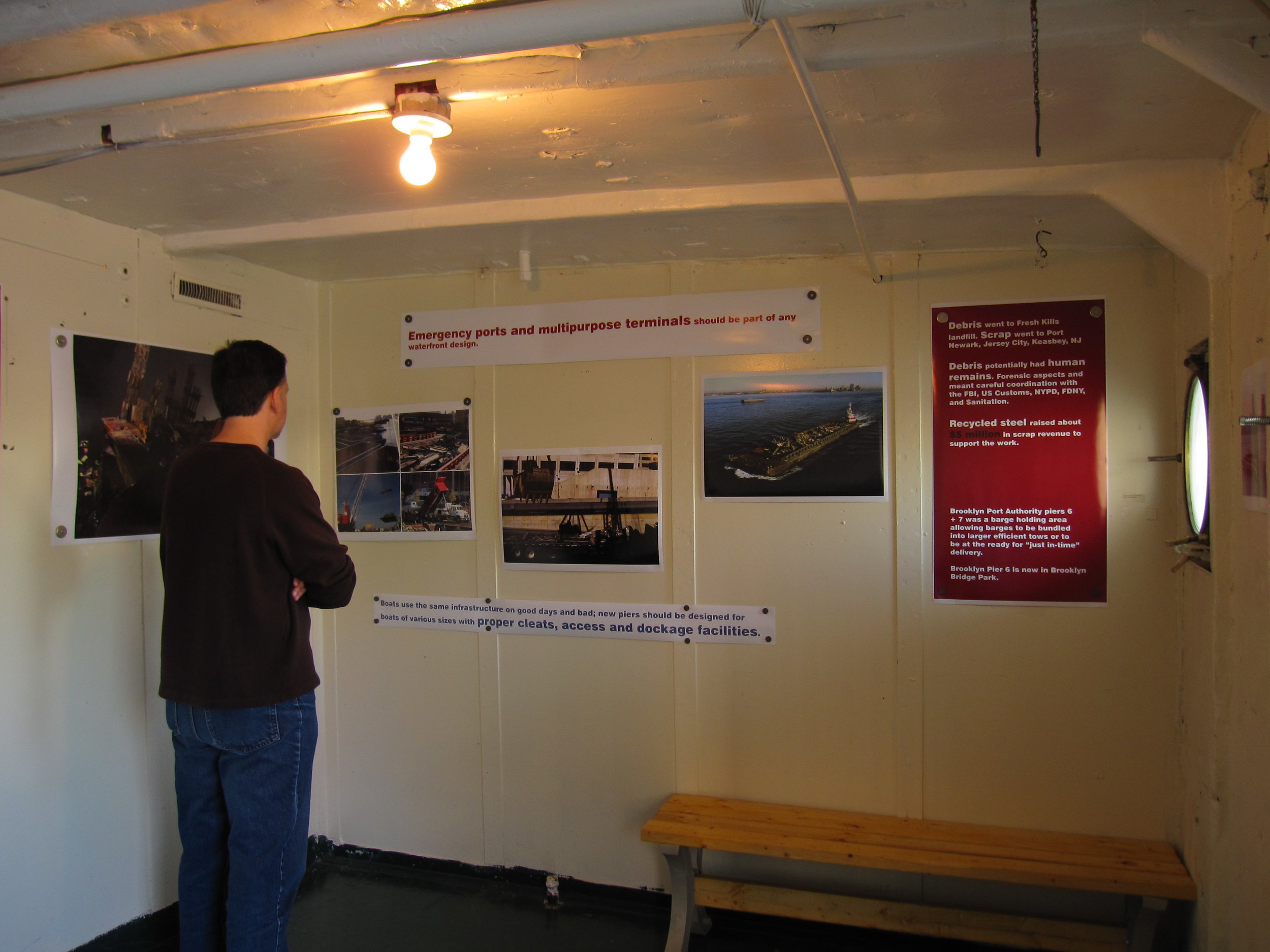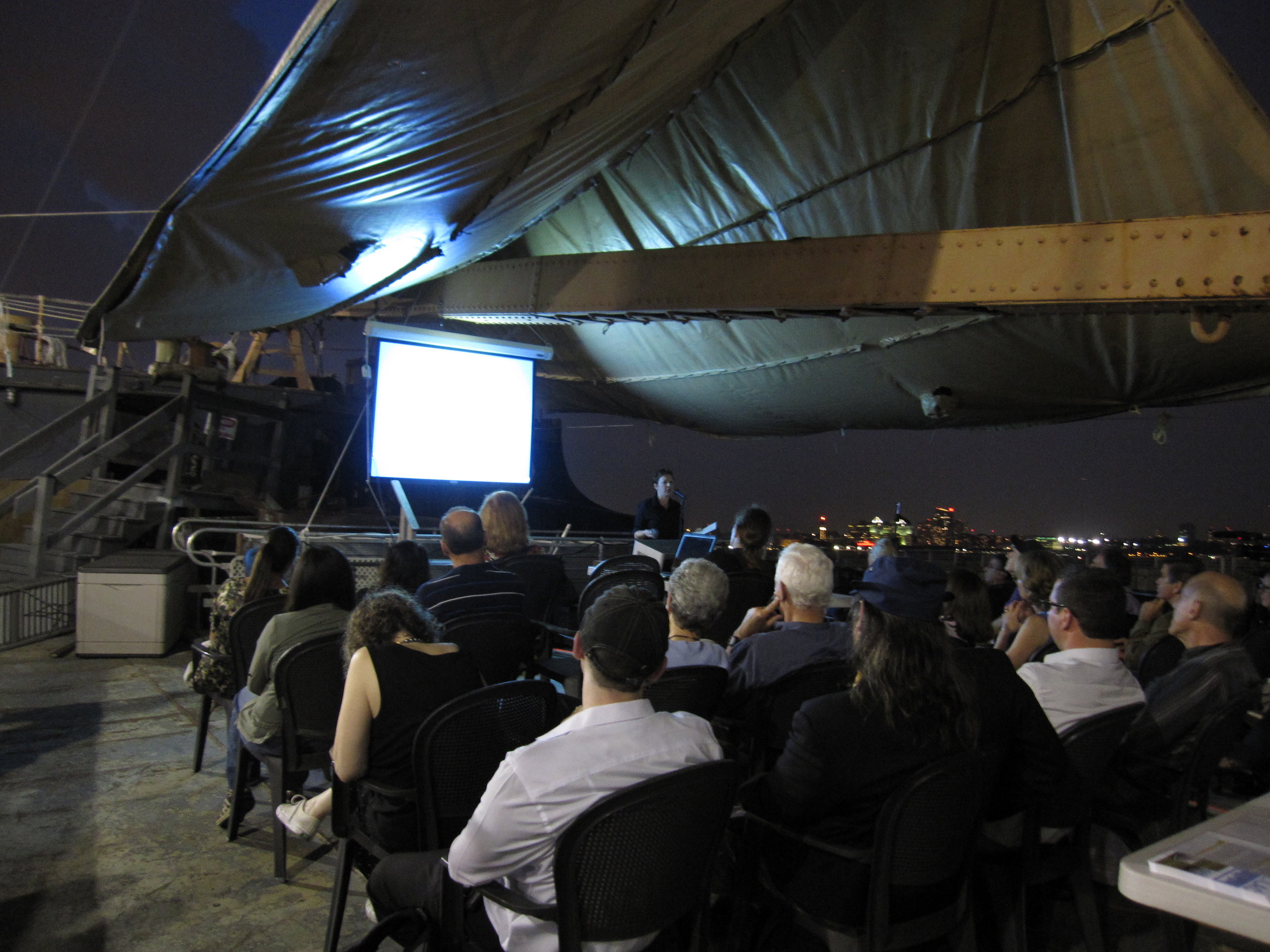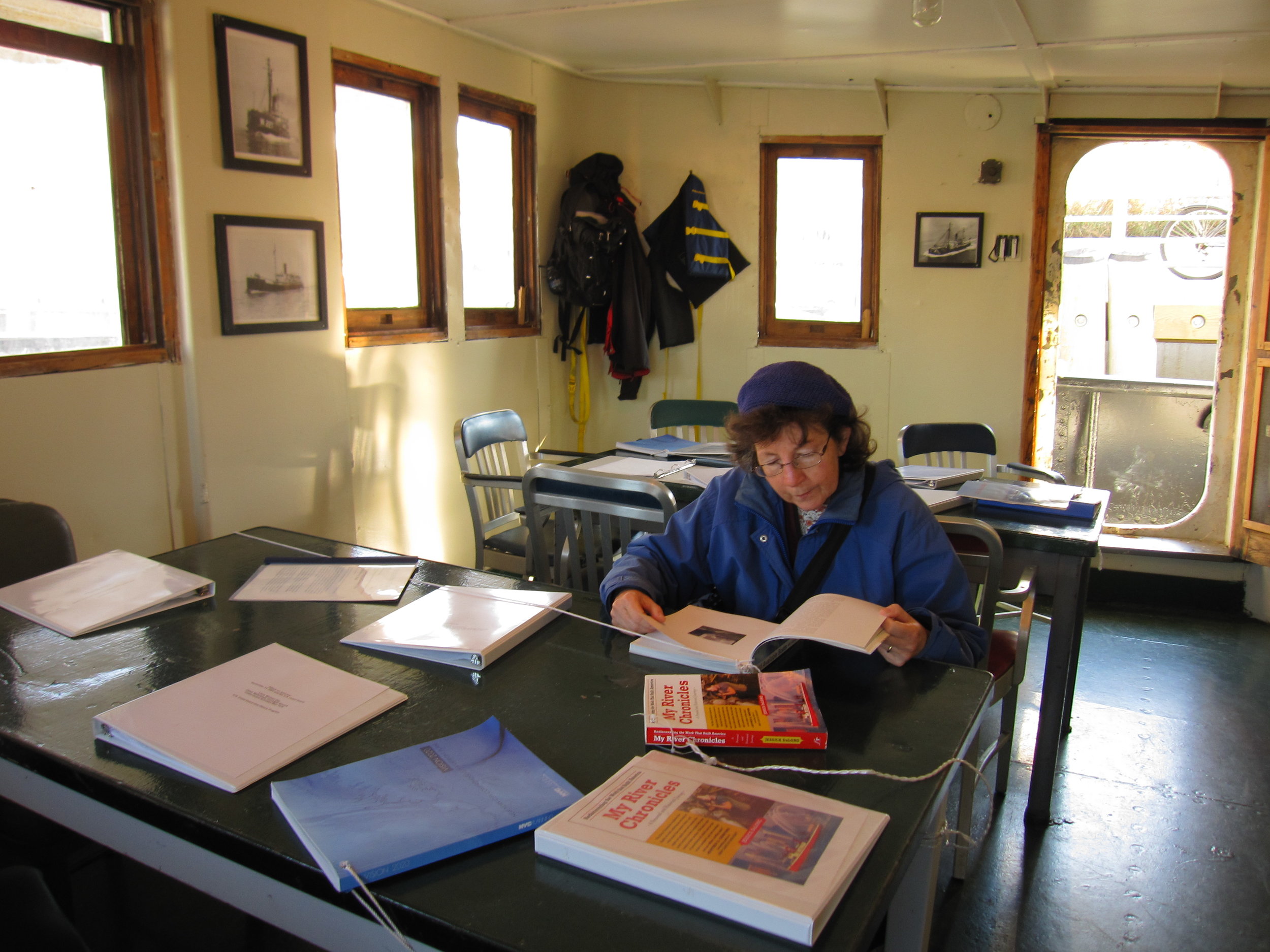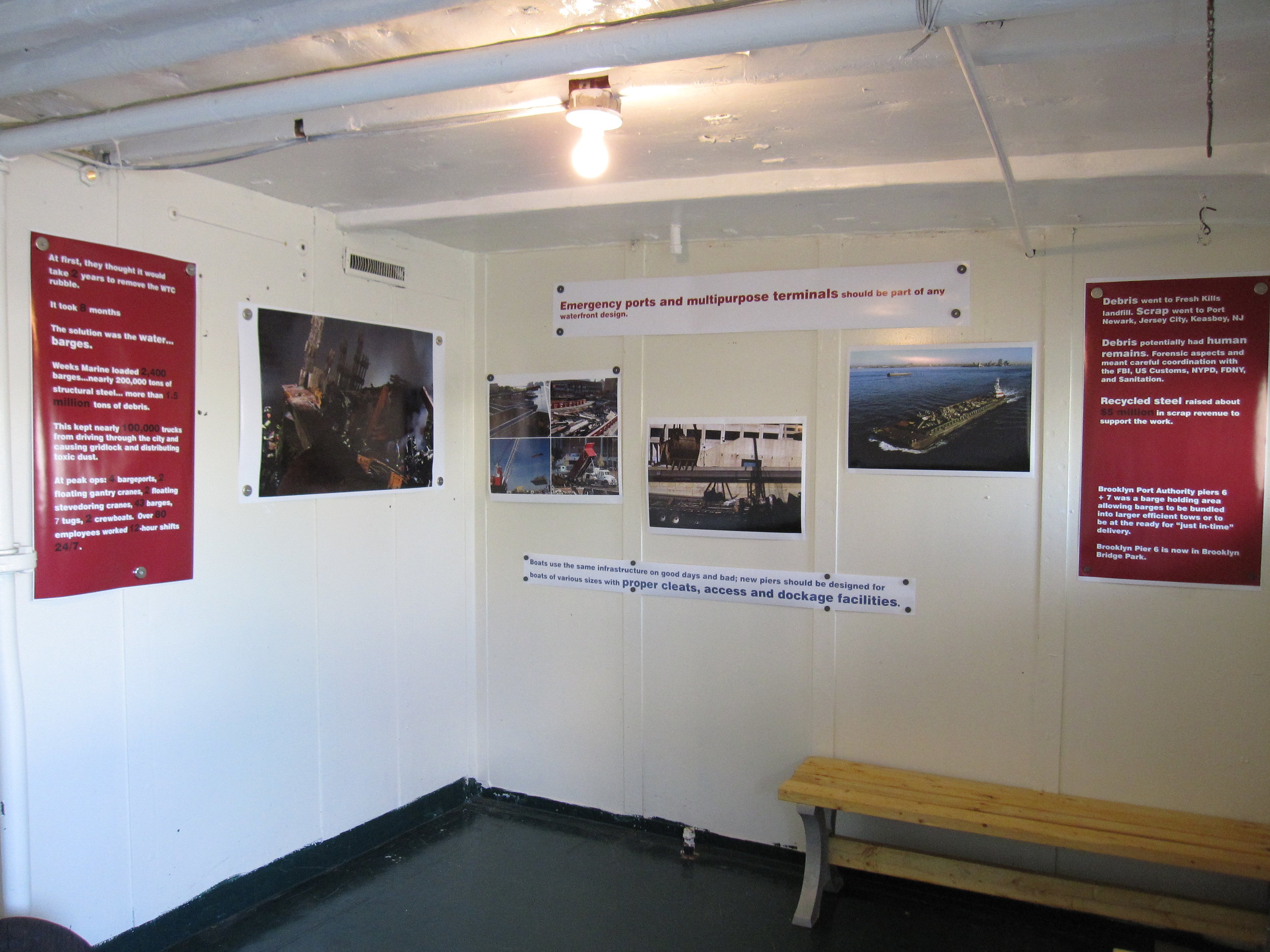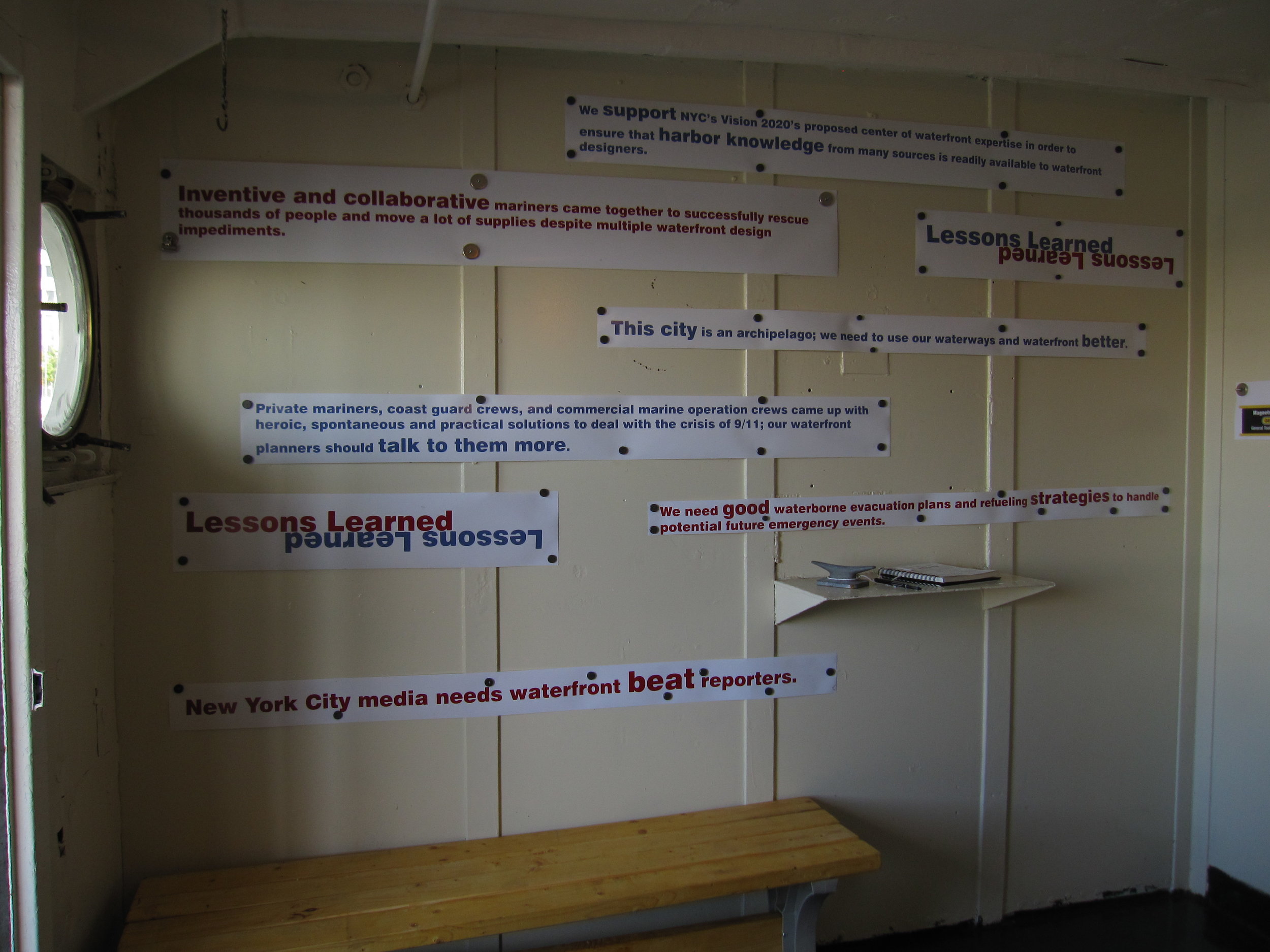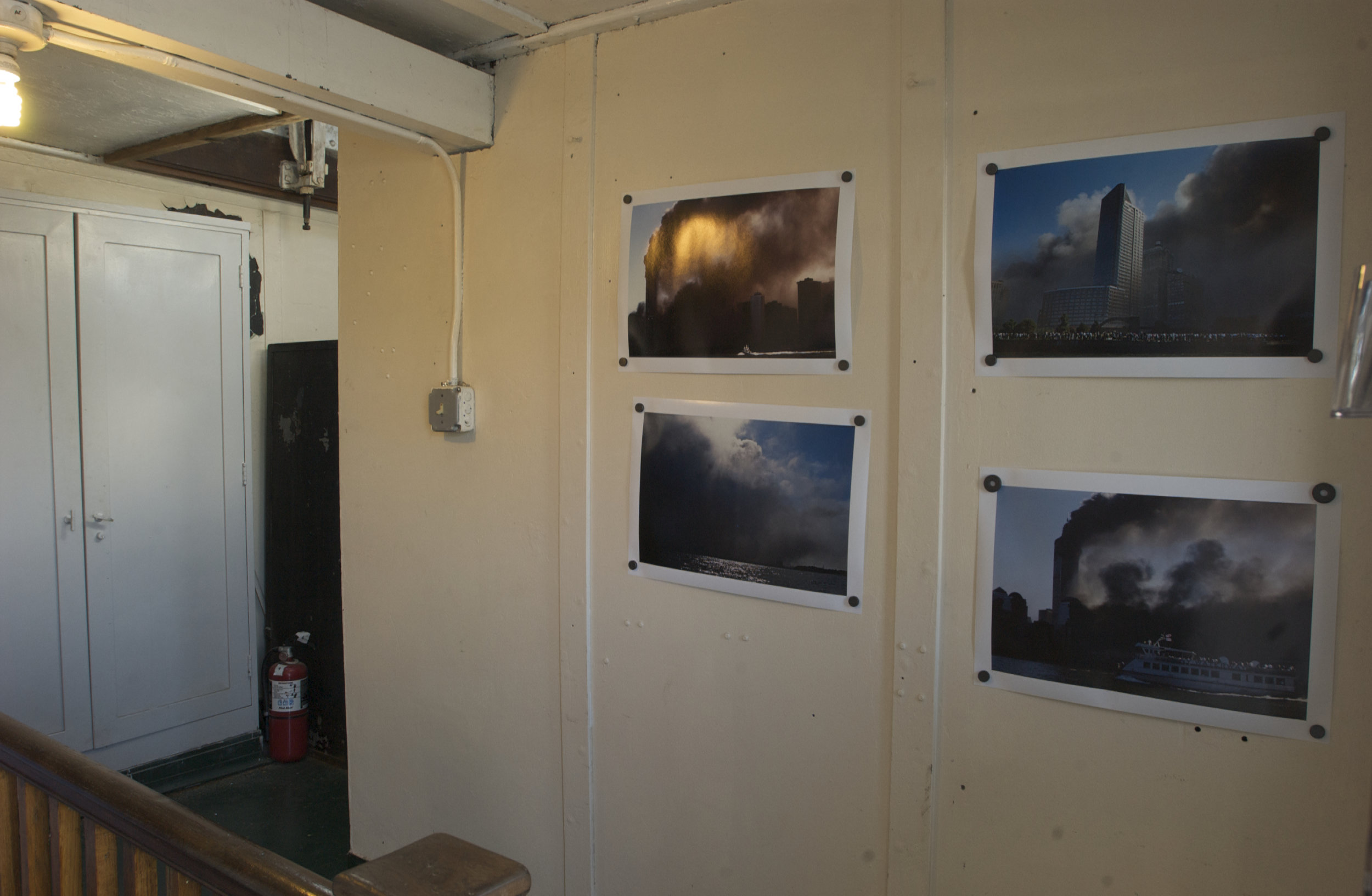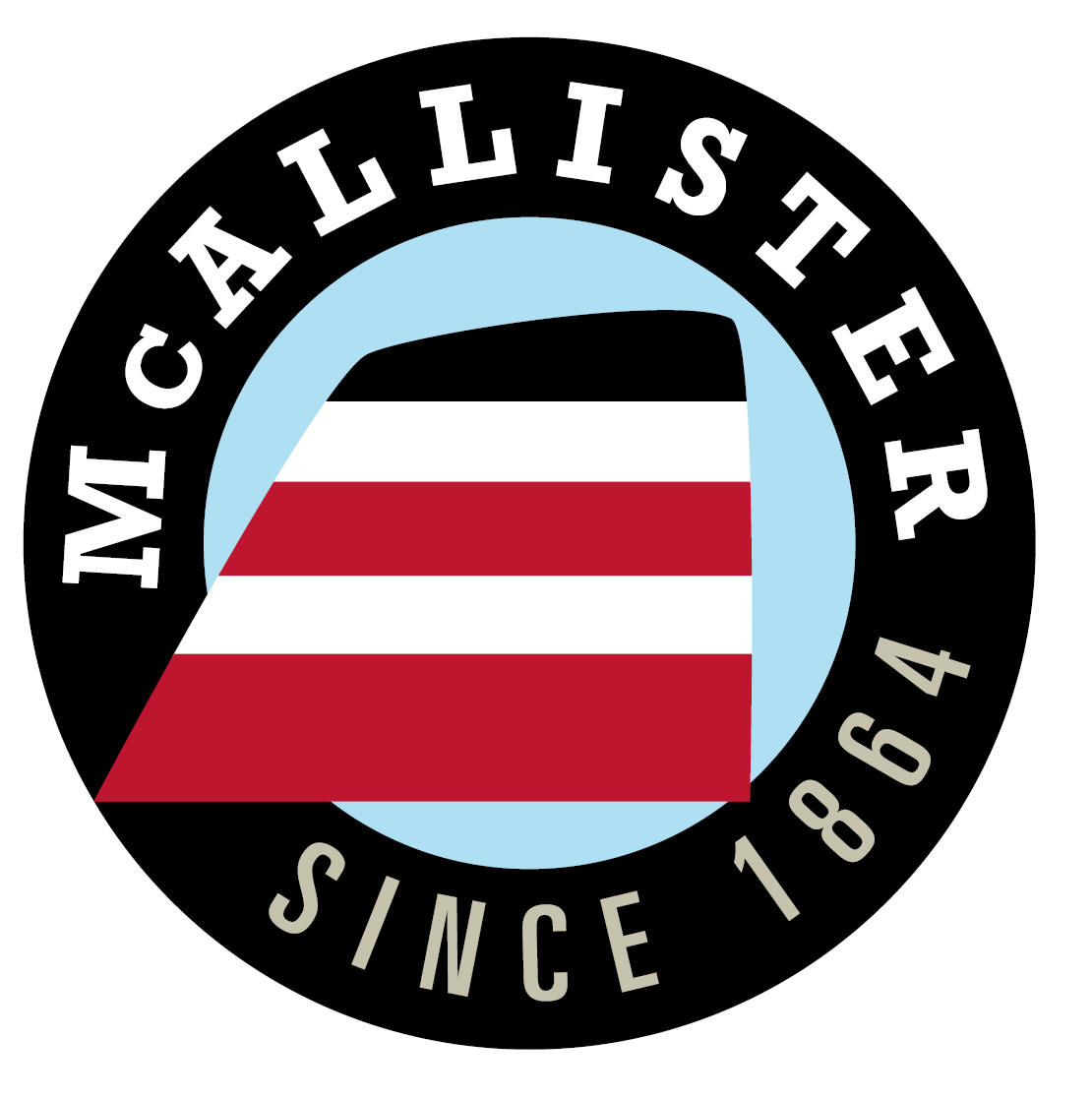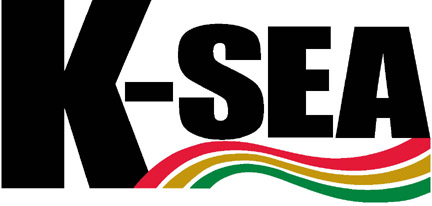Police boat heading towards manhattan. Photo (c) carolina salguero 2001. shot as she was steering her powerboat from red hook to the world trade center.
PortSide NewYork Exhibit "Mariners' Response to 9/11"
The 9/11 evacuation - greater than Dunkirk - and other stories
This page starts with a recap of the history and our 2011 exhibit, and updates are towards the botoom of the page. New in 2021, see our 2nd webpage with videos and oral histories. That section got too big for this page.
2021 was the 20th anniversary of the 9/11 attacks. On the 10th anniversary, PortSide NewYork curated and produced the exhibit described below. We keep this webpage as a permanent exhibit about these under-reported aspects of the 9/11 response in NYC and update it; and in 2021, we again created related programming. We welcome talking to people who are creating exhibits, articles, and videos about this content.
When 9/11 happened, PortSide’s founder and Executive Director Carolina Salguero was a photojournalist doing a story on tugboats in NYC, and she got to the World Trade Center in her own powerboat from Red Hook, Brooklyn. She is committed to growing understanding of the important role of the maritime industry on that day and following days, weeks, months and years and conveying what the maritime response to the attacks tells us about how NYC should be planning its waterfront differently with more #piers4boats. She curated the exhibit memorialized on this page.
We can create a travelling exhibit for your school, organization or work place. Please send us an email to discuss at chiclet@portsidenewyork.org.
On 9/11, local mariners were responsible for an evacuation greater than Dunkirk, between 350,000 and 500,000 people were transported from lower Manhattan by boat in just 9 hours, most in much less time. In contrast, the evacuation of Dunkirk took 9 days to move just under 350,000. There were 4 aspects to mariner's response to 9/11:
boatlift evacuation,
supply and support of ground zero,
removal of rubble by tug and barge,
two years of interim ferries.
Many of the reasons PortSide continues talking about this 9/11 story are forward looking: waterfront design should reflect the 9/11 story. The infrastructure and industry that helps on a bad day is an asset on good days for moving people and freight, for fun and recreation. We stress this by using the #piers4boats hashtag on social media and encourage pro-maritime people to use that hashtag.
All photos in slide show above are (c) Carolina Salguero 2001 except the photo from the fireboat John J. Harvey and some of the photos in the exhibit panel which include many of Salguero’s images, but not all.
The exhibit
In 2011, on the 10th anniversary of 9/11, PortSide NewYork created a multimedia exhibit about the extraordinary and relatively unsung role of mariners responding to the attacks in NYC, from evacuation to rubble removal. It included photography, text, videos, oral history and a reading room. Fittingly, the exhibit was installed on a ship - the former U.S. Lighthouse Tender LILAC - docked at Hudson River Park’s Pier 25, a pier from which Ground Zero rubble was removed. This page was a companion piece to the exhibit and is maintained as a permanent teaching tool and includes updates towards the bottom plus our 2nd webpage added in 2021.
A list of the boats involved in the evacuation is here. This was last updated 10/23/23.
The Manhattan effort was begun spontaneously by civilian boat operators - a key difference between Dunkirk and Manhattan during 9/11. The 9/11 boatlift is a story of fast-moving ingenuity, courage and generosity of spirit. The Coast Guard and Sandy Hook Pilots soon joined the effort, and all sectors of the marine community rapidly became involved. Within hours, more than 100 private and public vessels operated on scene. While the evacuation was still underway, the mariners began supplying Ground Zero; they sourced and delivered to rescue workers fuel, crucial supplies, and river water for firefighting.
What mariners did over 2 years
Largely unreported, the mariners' role continued from day one for two years.
The marine industry evacuated people, and immediately began bringing in personnel, supplies, fuel, and both potable and firefighting water. The retired fireboat JOHN J. HARVEY, which had greater pumping capacity than any active-duty NYC fireboat at the time, joined other fireboats and pumped harbor water to firetrucks which could not get water from the broken water mains. Dinner boats provided floating cafeterias and sleeping quarters.
The marine industry told NYC government that moving the rubble out by water would reduce the site clean-up time from two years to eight months and spare the city from the impact of the toxic dust being rolled through the city and from the traffic gridlock that much trucking could cause. The City agreed to the plan, and the marine industry (Weeks Marine and the US Army Corps working together) dredged two emergency barge ports, and Weeks then loaded all the WTC rubble onto barges and hauled those away with their tugboats (2,400 barges that kept 93,346 truck trips off the road), except for the ritual removal of “the last column” which left by truck.
An evolving system of emergency and temporary ferries and ferry terminals was created and ran for two years until PATH train service was restored.
Lessons for the future
9/11 underlined that Manhattan is an island; and in creating the exhibit, PortSide NewYork makes the point that the maritime 9/11 story has workaday implications for New York City as it develops new plans for its waterfront. Those lessons were in word strips in several exhibit rooms. Key among those lessons are:
recognize the importance of the working waterfront (many revitalization efforts devalue the industry and squeeze it out)
design the edge between land and sea so it is more boat-friendly
design the edge to be multi-purpose so it can serve during emergencies
The marine industry provided emergency services again with the ferry evacuation of Manhattan during the 2003 blackout, responding to the 2009 “Miracle on the Hudson” landing in the river of US Airways Flight 1549, and in various ways during and after 2012’s hurricane Sandy.
Stories too rarely told
Another lesson conveyed by our exhibit is that there is a lack of waterfront reporters with the result that stories such as we covered in the exhibit were and are rarely told and remain largely unknown. This is a problem that affects coverage in the present and going forward, not just the understanding of the history of 9/11.
The National September 11 Museum itself does not give much space to the mariners' role, just a little nook, and only covers the boatlift aspect of the response. The museum has a special exhibit that covers the 9/11 day itself. Within that, there is a long horizontal timeline which displays what was happening in the air on top and what was happening on the land below. We believe the huge maritime story should be on that timeline too.
Videos in the exhibit
"Boatlift" (above) narrated by Tom Hanks, funded by Center for National Policy
Pier 25 After the Fall by Mike Mazzei, dockbuilder, his of removing WTC rubble at the same Pier 25 where the exhibit was installed on the LILAC
Rescue at Water’s Edge by MARAD
Oral Histories
Produced by Carolina Salguero in 2001. Hear the following at this link.
Capt. Wayne Carnis and Deckhand Mike Scanlon of tug VIVIAN ROEHRIG
Capt Ken Pederson, Reinaurer
Capt. Mike Rice of tug KATHLEEN WEEKS
Deckhand Sam Dawson, tug SHELBY WEEKS
"Harbor Voices from 9/11" produced by David Tarnow. You can hear the following at this link. Related New Audio Documentary by David Tarnow. A book "All Available Boats" contains transcriptions of these interviews, portraits of each person and documentary photos many of which are by PortSide's Carolina Salguero.
Paul Amico (right) was a special docent during OHNY weekend.
James Parese, Captain, Staten Island Ferry SAMUEL I. NEWHOUSE
John William Akerman, Sandy Hook Harbor Pilot
Paul Amico, builder/maintenance of most ferry docks in NYC at the time.
Kimberly Gochberg, Intercollegiate Sailing Coach, U.S. Merchant Marine Academy
Tom Sullivan, crew Marine 1 fireboat JOHN D. MCKEAN
Ken L. Peterson, Jr., Port Captain, Reinauer Transportation
Huntley Gill, retired FDNY fireboat, JOHN J. HARVEY
Tim Ivory, Engineer, retired FDNY fireboat, JOHN J. HARVEY
Lee F. Gruzen, Battery Park City resident
Texts in Reading Room
The reading room contained transcripts of many oral histories and some magazine articles. Below are links to some.
Jessica DuLong, author of book My River Chronicles: Rediscovering the Work that Built America; A Personal and Historical Journey (Free Press, 2009). See her new book May 2021 Saved at the Seawall and see excerpts from My River Chronicles here.
Offshore Magazine article, "A Sea of Heroes," by Betsy Haggerty
Book All Available Boats. This includes considerable photography by PortSide's Founder and Director Carolina Salguero who was a photojournalist at the time and got to ground zero in her own boat, the only journalist to do that.
Vision 2020, NYC's new comprehensive waterfront plan
Transcribed Oral Histories
Rear Admiral Richard E. Bennis, Coast Guard Captain of the Port
Lieutenant Michael Day, Chief, Waterways Oversight Branch, Coast Guard NewYork
Bill Esola, commercial driver
Arthur Imperatore, Jr. President, New York Waterway
John Pensiero, marine engineer
Ship Lore & Model Club Presentation
LT Michael Day, USCG
Capt. Andrew Mcgovern, Sandy Hook Pilots
Ken Peterson, Port Captain, Reinauer
Sven Van Batavia, VP, Miller's Launch, Inc.
Tour the exhibit via slideshow below
New for youth in 2021 and 2022:
PortSide helped Scholastic Magazine create articles about the boatlift adapted for two age levels, completed late this summer. They are in Storyworks (grades 4-6) and Scope (approx. grades 6-8). You need to subscribe to get access to these. Digital-only subscriptions are available for $8.99 for Scope and $7.65 for Storyworks. That gives access to this article as well as other current stories and 5+ years of archive content.
In addition, PortSide has several children’s books about the 9/11 boatlift and is ready to create youth programs for interested schools. If your school is interested in a program about the maritime 9/11 story with us, please send an email. Our public exhibit will be up, outside in PortSide Park and on our ship deck until 9/26/21; come by anytime for that. The video booth on deck will be shut down if it is raining.
Jessice DuLong, the author and marine engineer cited on this page, has an article about how to talk about 9/11 and other traumatic events on CNN here.
Prior updates:
Read this 8/16/18 article about the 9/11 response of Rich Naruszewicz who was Captain of the fast ferry THE FINEST on 9/11 and evacuated thousands of people. The ferry is now operated as a ferry in Washington State. Naruszewicz is a former crew member of the MARY A. WHALEN, PortSide’s flagship
In 2017, the book “DUST TO DELIVERANCE: Untold Stories from the Maritime Evacuation on September 11," by Jessica DuLong was released. The book has been re-released in paperback, with a new preface and a foreword by Mitchell Zuckoff (FALL AND RISE), under the title SAVED AT THE SEAWALL: Stories from the September 11 Boat Lift. here is her comparison of Dunkirk and the 9/11 boatlift. DuLong worked as engineer on the fireboat JOHN J. HARVEY during their response to 9/11.
In 2016, a book was released, American Dunkirk, about the waterborne evacuation. This book was written after years of research by the Directors of the Disaster Research Center at the University of Delaware. The Center's focus is improving emergency response and understanding human behavior in emergencies.
2016 WNYC radio interview with PortSide President Carolina Salguero about her experience documenting the 9/11 boatlift changed her life and led to the creation of PortSide.
March 2016, our President Carolina Salguero spoke on a panel at the AIANY (she starts at 47:50) and emphasized that post- Sandy resiliency planning should not erase the lessons of 9/11, saying "we need to re-portify as we fortify." The resiliency plan for lower Manhattan, the Big U, is essentially a wall, and ports are apertures. NYC needs resiliency (flood protection) measures that have apertures.
June 2016 interview of Coast Guard Officer Brandon Brewer about his role on 9/11 by the blog undicisettembre. (Also available in Italian).
The Coast Guard has released audio files of September 11 marine broadcasts. Starting with the New York Command Center receiving initial notification from the sailing vessel Ventura of an explosion at the World Trade Center, on Sept. 11, 2001 the recordings continue (in four parts) documenting the U.S. Coast Guard's coordination of the largest maritime evacuation in U.S. history; nearly 500,000 people were transported by boats from Lower Manhattan after the attacks.
Links to audio files: 1, 2, 3, 4
Transcription of part 1, part 2
228 page Coast Guard report “Rogue Wave, The U.S. Coast Guard on and after 9/11”
Exhibit Content Advisers
& Contributors
Carolina Salguero - Curator
Paul Alter - Exhibit Design
Brandon Brewer, USCG at time of 9/11
Center for National Policy
John Doswell
Jessica DuLong, Engineer, fireboat JOHN J. HARVEY, journalist
Huntley Gill, Captain, Engineer, fireboat JOHN J. HARVEY
Lee Gruzen
Betsy Haggerty
David Hodgson
MARAD
McAllister Towing
Mike Mazzei
Rich Naruszewicz
Alan Olmsted
Jack Putnam
Rick Spilman
Jim Sweeney
David Tarnow
US Coast Guard
Weeks Marine, company that removed rubble by tug and barge
Will Van Dorp
Special docents during OHNY weekend:
Betsy Haggerty, maritime journalist, former editor Offshore Magazine, author of award-winning article about 9/11.
Norman Brouwer, renowned maritime historian is on hand to talk about the Lilac.
Paul Amico, builder of most ferry docks in NYC, a kayaker, major aid to Manhattan's evacuation and an oral history subject in the exhibit. Hear him here
Related Talk
Carolina Salguero and journalist Jessica DuLong, author of the critically acclaimed book "My River Chronicles: Rediscovering the Work That Built America," and chief engineer of retired New York City Fireboat John J. Harvey, which was called back into service to supply firefighters with Hudson River water.
More about the LILAC Preservation Project:
Our exhibit was installed on the LILAC. The U.S. Lighthouse Tender LILAC was launched on May 26, 1933. Built for the U.S. Lighthouse Service, she carried supplies and personnel to lighthouses and maintained buoys. The duties of the Lighthouse Service were later absorbed by the U.S. Coast Guard. LILAC was decommissioned by the Coast Guard in 1972. She was the last ship in the Coast Guard fleet to operate with reciprocating steam engines and is unique in still possessing her original engines. She is on the National Register of Historic Places and is eligible to become a National Historic Landmark. The ship is owned by thenon-profit.
Exhibition Design:
This exhibit was curated by PortSide NewYork Director Carolina Salguero who was working as a photojournalist on 9/11. She was the only photojournalist to arrive at Ground Zero in her own boat, and created award-winning images of scenes on the water and at Ground Zero. See videos about her 9/11 reporting here and here.
The exhibit was planned and designed in a 2.5 week charrette by Paul S. Alter, a principal at LHSA+DP, Lee H. Skolnick Architecture + Design Partnership. LHSA+DP is a NYC based architecture and design firm that creates "narrative" architecture and interpretive exhibition projects.
The firm has been recognized for its immersive and innovative approach to design as interpretation and garnered numerous awards for its work in both the public and private sector.
LHSA+DP has created exhibitions and installations for such venerable institutions as the Smithsonian Institute, Cooper Union, The New York Historical Society, The New York Hall of Science, and the Chicago Academy of Science.
A passionate sailor and amateur mariner himself, Alter worked during 2011 with PortSide as a desigNYC advisor to the BoatBox project, another PortSide waterfront endeavor.
With practically no time and budget, he and Yun Chu Chou, a summer intern, jumped in wholeheartedly, embracing the ship as an integral part of the exhibit experience.
A journey through the ship and through the time-line of the 9/11 events became a key organizing structure for the exhibit. They focused on the exhibit's three key themes, 1) Rescue and Evacuation 2) Rubble Removal and 3) Lessons Learned.
A quick site visit on board the LILAC revealed that visitors should be led through the inherently narrow, awkward and difficult passageways of the ship and that these tight circulation spaces would make atmospheric galleries.
One hall was filled with images overhead and image+word collages on the sides. Two small cabins offer a respite from dense imagery and provide oral histories and videos. At the the stern of the ship, a grand semi-circular cabin was was made into a reading room where visitors could quietly sit and drill down into more detail.
The multi-media experience is also multi-sensory with river breezes passing through open portholes, the constant gentle movement of LILAC, the smack of the waves against the hull, and the sounds and smells from the waterfront and the ship itself, all of which becomes integral to the visitor's journey and helps evoke the mariner's experience.
This is an elemental installation meant to provoke thought about the mariner's world and to enhance people's understanding of the critical role that mariners played in responding to the 9/11 emergencies.
Thanks to our sponsors!
WISTA, McAllister Transportation, Weeks Marine, LHSA+DP, New York Shipping Association, K-Sea Transportation
